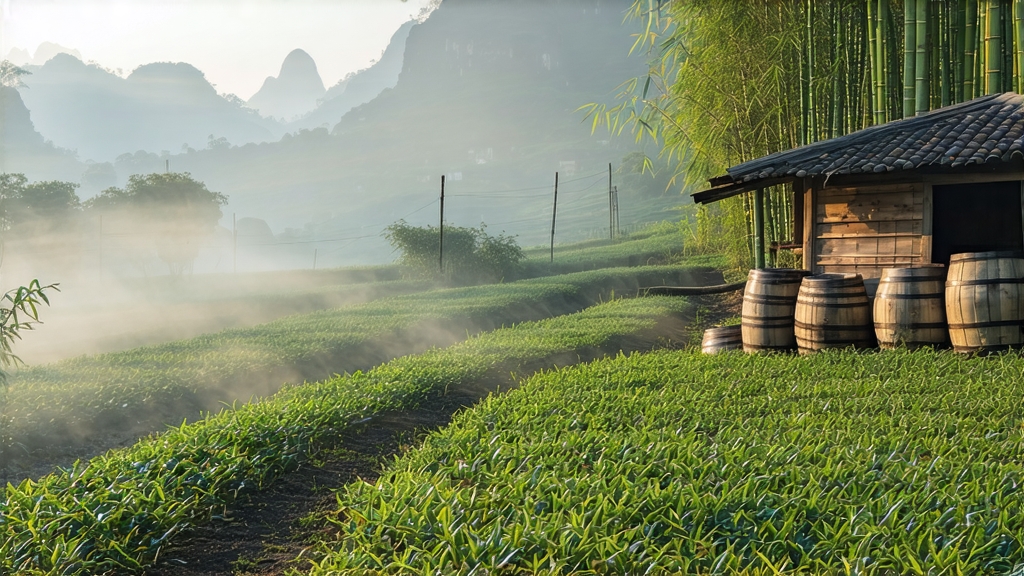
Liu Bao, literally “Six Forts,” is the name of a small riverside town in Wuzhou, Guangxi, but it is also the name of one of China’s oldest intentionally fermented teas. While Pu-erh has conquered international menus, Liu Bao remains a quiet insider’s secret, a tea that once fueled caravans on the Tea Horse Road and still ferments patiently in bamboo baskets stacked to the rafters of century-old warehouses. To taste Liu Bao is to sip the humid subtropics of southern China, the mineral breath of the Liujiang River, and the ghost of a trading culture that moved tea by boat, hoof, and shoulder for more than 1,500 years.
History: From Frontier Garrison to Global Steamer Trunk
The earliest written record appears in the 1,500-year-old “Guangxi Local Chronicles,” describing tea tribute sent from Cangwu County (modern-day Wuzhou) to the imperial court during the Liang Dynasty. By the Tang era, Liu Bao tea was compressed into long poles, wrapped in bamboo skin, and lashed to the saddles of muleteers who crossed the Yunkai Mountains into Guangdong and, eventually, to the port of Guangzhou. There, clipper ships carried it to Southeast Asia where miners and dockworkers prized its ability to “cut the grease” of a rice-heavy diet and ward off malaria in the torrid climate. In 1886 the British colonial government of Malaya listed “Liu-pu” (a Cantonese mis-pronunciation) among taxable imports, proof that the tea had already outgrown its mountain cradle. When the Qing dynasty lifted the maritime ban in the late 17th century, entire boatloads left Wuzhou for Hong Kong, Saigon, and Singapore; some of those 80-year-old bales still surface in Malaysian “Kopitiam” cupboards, their leaves glossy with age and redolent of betel nut and camphor.
Terroir and Leaf: The Subtropical Mineral Canvas
Liu Bao grows between 200 and 800 m on the granite-and-sandstone foothills of the Dayao Mountains. The monsoon climate delivers 1,500 mm of rain during the six-month growing season, while frequent fog filters sunlight into a soft, diffused glow ideal for the large-leaf Camellia sinensis var. assamica cultivar native to Guangxi. The soil is lateritic, rich in iron and potassium, and drains rapidly; locals say the tea absorbs the river’s “sweet bones,” a minerality that later translates into a silky, stone-fruit broth. Farmers traditionally keep 30- to 60-year-old bushes, pruning them into waist-high “tables” that can be plucked without ladders; older trees are left to climb into small trees whose roots reach deep enough to pull up trace selenium, giving aged Liu Bao its signature metallic shimmer on the tongue.
Craft: When Fire, Water, and Bamboo Conspire
Unlike Pu-erh, which relies on raw-material microbial potential, Liu Bao undergoes a mandatory “wet piling” stage invented centuries before the word “fermentation” entered Chinese tea lexicons. The process begins in late April when two-leaves-and-a-bud are plucked, wilted briefly, then wok-fired at 280 °C for eight minutes to kill green enzymes. While still warm, the leaves are rolled until they “sweat” a grassy sap, then sun-dried to 70 % moisture. Here the magic diverges: workers build a 1.5-meter heap on a cement floor, spray it with Liujiang river water, and cover it with wet jute sacks and banana leaves. Inside this compost-like mound the temperature climbs to 55 °C within 24 hours; thermophilic bacteria and Aspergillus niger begin to break down cellulose, releasing glutamic acid that will later manifest as soy-savory “xian-wei.” Every three days the pile is turned, aerated, and re-moistened; after 15–25 days the leaves have turned chestnut-brown and emit the unmistakable scent of damp earth and salted plum. Next comes the unique “basket roast”: semi-fermented leaves are stuffed into 50 kg cylindrical bamboo baskets lined with rice-paper and placed above a gentle charcoal fire for six hours. The heat fixes the color,